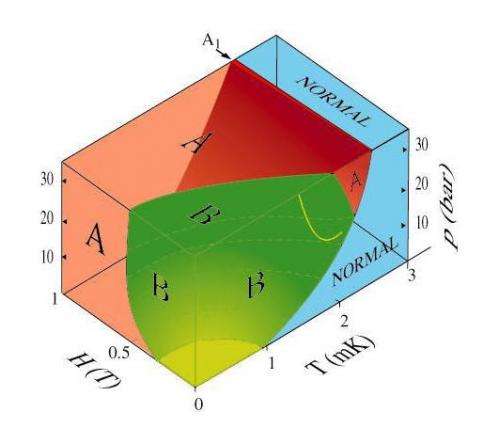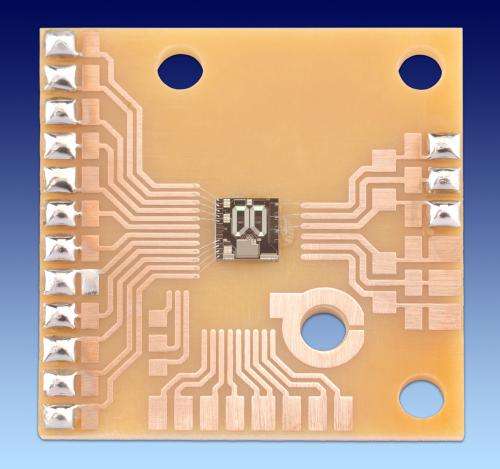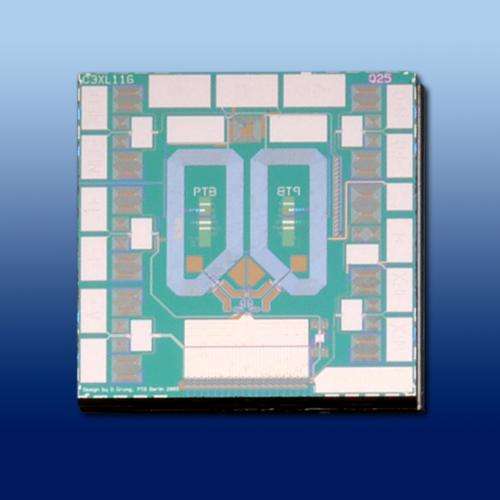May 22, 2013 report
Novel features of helium-3 superfluidity discovered with new SQUID detector chip

(Phys.org) —In order to study many complex phenomena, physicists seek to isolate them in potential wells or boxes with easily described forms and boundary conditions. These features in turn dictate various behaviors of the system under study like, for example, equilibrium states or resonances. In recent times it has emerged that constraining particles on extremely small scales can result in interesting new behaviors. Artificial atom systems, like quantum dots, can be fine-tuned in this way to specific color or conductivity according to their dimension. In some cases, even the phase of a material can be manipulated. A group of researchers has recently demonstrated the ability to precisely control the phase structure of superfluid helium-3 by manipulating the geometry of the container that holds it, and applying an appropriate magnetic field. Their new paper, recently published in Science, describes how they used an ultra-sensitive SQUID detector to readout the NMR spectra that reveals the phase information.
With two protons, neutrons, and electrons, helium-4 has an overall spin of zero, and is therefore known as a boson. In the form of Bose-Einstein condensate, it shows just a single mode of superconductivity and superfluidity (a fluid that shows no viscosity). In contrast, helium-3 has a spin of plus or minus one half making it a fermion. Having a higher level of broken symmetry, helium-3 can support several varieties of superfluidity, which makes its phase diagram much richer. The simplest phase diagrams are pressure-temperature plots with equilibrium lines to indicate the state. Since helium-3 has nuclear spin of one half, it is affected by a magnetic field. The phase diagram of helium-3 can be extended to a third dimension representing the effect of a magnetic field. The phase boundary is then split between normal and superfluid components.
The effect of reducing one of the walls of the container which holds the helium-3 is to change the preferred direction of the orbital angular momentum. When this dimension approaches the size of the Cooper pair coherence length, the superfluid state is suppressed in that direction, along with additional symmetry breaking. (The coherence length is the mean-square radius of a Cooper pair.) The phase of helium-3 can be described by an "order parameter," which according to the standard Ginzburg-Landau formalism, expresses the free energy of a superconductor. The authors of the new Science paper were able to determine the order parameter from the line shape of the NMR spectra of helium-3.

Other researchers had conducted similar investigations using NMR, however the signal to noise ration in the readout system limited the conclusions that could be drawn. The NMR also requires a significant magnetic field which complicates the effect of the magnetic field needed for manipulating the phase. Because of the small volumes involved, the magnetic fields used need to be low to prevent additional symmetry breaking. Typically, NMR instruments use a simple pick up coil to read out the LC circuit of the instrument. The new study used a SQUID device manufactured by Physikalish-Technische Bundesanstalt (PTB), which permitted a more sensitive detector to be built.
The PTB sensor chip is ideal for obtaining low temperature NMR fingerprints of extremely thin helium-3 layers—essentially thin films. In addition to being able to discover new superfluid phenomena, the researchers hope to be able to investigate excitations at the surfaces of the various helium-3 phases known as Majorana fermions. A Majorana particle is a fermion that is its own antiparticle. These particles exist as quasiparticle excitations in superconductors and have recently been the focus of many intense research efforts.

Superfluidity has also found applications in high-energy physics and theories of quantum gravity, namely superfluid vacuum theory. The ultimate goal here is to develop a model that would unify quantum mechanics with gravity. For now, the researchers have plenty of experiments ahead to keep themselves busy. Improved sensor arrangements are expected to be able to resolve spatial features helium-3 films, which should in turn lead to new discoveries about superfluidity.
More information: Phase Diagram of the Topological Superfluid 3He Confined in a Nanoscale Slab Geometry, Science 17 May 2013: Vol. 340 no. 6134 pp. 841-844 DOI: 10.1126/science.1233621
ABSTRACT
The superfluid phases of helium-3 (3He) are predicted to be strongly influenced by mesoscopic confinement. However, mapping out the phase diagram in a confined geometry has been experimentally challenging. We confined a sample of 3He within a nanofluidic cavity of precisely defined geometry, cooled it, and fingerprinted the order parameter using a sensitive nuclear magnetic resonance spectrometer. The measured suppression of the p-wave order parameter arising from surface scattering was consistent with the predictions of quasi-classical theory. Controlled confinement of nanofluidic samples provides a new laboratory for the study of topological superfluids and their surface- and edge-bound excitations.
Journal information: Science
© 2013 Phys.org



















